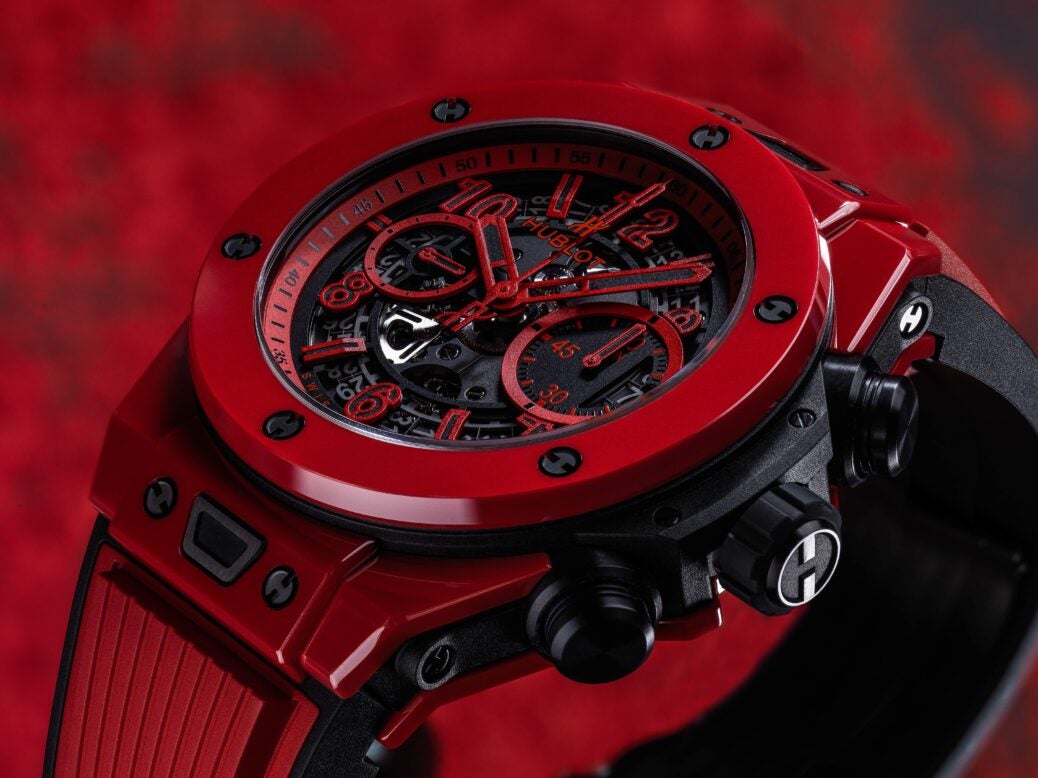
The Swiss brand continues to defy convention in the most colourful ways, writes Timothy Barber
Amid the watch industry’s reliance on retro designs and vintage revivals, a gradual embracing of broad and unusual colours has been one encouraging trend for those of us
who reckon watch design needs to look forwards as well as back. It’s no longer a total shock to see watch dials in pink, yellow or green, while even bezels and cases have been occasionally appearing in interesting new shades and textures.
Nevertheless, the red-all-over watch that Hublot unveiled at Baselworld watch fair in March, forged from ‘Red Magic’ ceramic for which the brand has established a patent, was still quite the bombshell: boldly magnificent in design, utterly unusual, technically audacious and as subtle as a brick to the forehead. Hublot to a tee, in other words.
It’s entertaining to think that 15 years ago, when Hublot was taken under the transformative wing of the charismatic Jean-Claude Biver, it was seen as a brand that, while modern, was also rather discreet. Founded in 1980 during Switzerland’s suffering at the hands of currency crises and Japanese quartz watches, it was an oddity: a brand known for slim watches inspired by the look of a ship’s porthole (‘hublot’ in French) that stood out for its fusion of precious gold cases with sporty rubber straps.
Known at that time for reviving Blancpain and leading Omega to great successes, Biver remade Hublot to fit his own exuberant temperament. It worked: a decade ago he sold Hublot to LVMH, and both he and the brand have been growing in stature ever since.
Biver’s philosophy is simple, and he’s given to bellowing it out at any opportunity: ‘Be first, be unique, be different.’ He launched a new totemic watch, a beefed-up chronograph version of Hublot’s classic style, that he christened the ‘Big Bang’; and he proclaimed ‘the art of fusion’ the brand’s raison d’être.
That has meant wacky adventures in unexpected materials, from carbon-fibre minute repeaters to watches with tweed dials or cases of see-through purple sapphire, as well as the invention of a redoubtable gold/ceramic alloy called Magic Gold.
It’s also meant a conveyor belt of limited editions with commercial partnerships, including the Fifa World Cup and Ferrari, and collaborations with creative players
of a similarly outré disposition. These have included Lapo Elkann, the playboy scion of the Fiat-owning Agnelli dynasty; Depeche Mode, the electro-rock band; the tattoo artist Maxime Büchi; and most recently artist Richard Orlinski, the ‘French Jeff Koons’, whose faceted take on the Hublot case is another stand-out.
All this makes it as easy to dismiss Hublot as to admire it – it depends on what side of the taste divide you fall, and there’s no shortage of people who recoil from the idea of taking Hublot even slightly seriously. This is a brand, after all, that refers to its own fans under the icky title of ‘Hublotista’ – which seems almost like self-parody.
But there’s something about Hublot that I find remarkable, and that’s the rate and intensity of its inventiveness. Other brands muck around for years developing new products that miss the moment by the time they arrive. Hublot encourages creative thought and cares not a jot whether its latest humdinger is up anyone’s street or not.
‘Sometimes even our retailers say we have too many models, but that’s Hublot – we go fast, and it works,’ Hublot’s head of product development once told me. ‘It’s a really entrepreneurial approach; we don’t think about things over a lot of months – if we think something is innovative and suits the brand, we go, and we go very fast. Our reactivity is the key, it’s very different.’
Prodigious output
Hublot creates around 40,000 watches a year, of which an ever-increasing proportion are powered by its own in-house movements, which range from its Unico chronograph engine (the power behind the Big Bang) to complex tourbillons and high complications. On its way, it has created super-watches including the cobra-shaped ‘La Ferrari’, with a power reserve of 31 days; a piece with a movement inspired by the Antikythera Mechanism, the analogue astronomical computer built by the ancient Greeks; a series of watches cased in see-through sapphire crystal, including a new example with a 16-day power reserve; and most recently a watch for golfers that will count the shots you take per hole. And it’s also just announced a smartwatch for football referees, which will be on the wrists of those adjudicating at the World Cup this summer.
Biver is now overlord of all LVMH watchmaking (including TAG Heuer and Zenith), with Hublot just one more piece of the pie. But one suspects that, for him at least, it remains by far the tastiest; and while it’s putting out all-red watches as luxuriously beautiful as the Red Magic, I’m almost tempted to agree.






